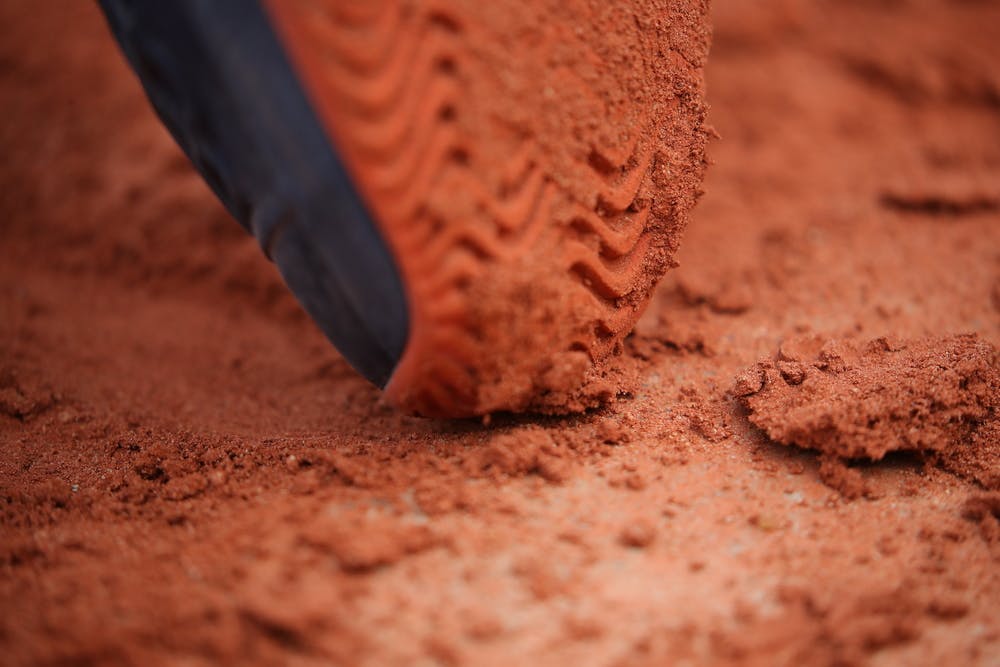When visiting Roland-Garros, you can refer to this handy guide of French tennis terminology - among other useful phrases - that will give your spectator experience a boost.
Roland-Garros jargon explained
From terre battue to La Monf, les serres to simple dames, your dictionary is here.

Balayage
In fashionable hairdresser-speak, balayage is the technique of hand-painting dye onto the hair to give it a natural, gradual transition of colour (similar to ombre) and it comes from the French verb 'to sweep'. At Roland-Garros, le balayage is the routine sweeping of the courts with giant brooms and le balayeur is one of the 100-strong clay-court maintenance team.
Chapeau
If you want to say congratulations in French (and sound like a local) you can say “Chapeau!” If you want to buy some headgear in the shop, these are the words to know: la casquette is a cap; la visière is a sun-visor; le trilby marine is a narrow-brimmed hat trimmed with blue; le trilby cloche terre battue is the women’s version trimmed in RG terracotta; le panama is self-explanatory; la capeline paille is a women’s wide-brimmed straw sunhat; and le trilby enfant is the cutest hat ever.
Coupe
A glass (as in champagne), a cup or bowl (as in a receptacle for ice cream) or a slice (as in cheese) are all perfectly respectable translations of this word, but in sporting competitions, la coupe has to be visualised in the grandest possible extreme as it translates as trophy – as in La Coupe des Mousquetaires (men’s singles trophy) or La Coupe Suzanne-Lenglen (the women’s prize).
Débâchage
The technical term for uncovering the courts. English-speaking tennis communities refer to dressing and undressing the court for play, but debachage deconstructs very literally to “taking the tarpaulin off” and has absolutely no association with the similar French word for debauchery.
Filet
The net. Not the cut of beef you eat with frites.
Kiki
In recent years, the only Kiki on first-name terms with the general public was the home fans’ favourite Kristina Mladenovic, unseeded this year. Whisper it, but this year there is a more stellar Kiki: the fourth-seeded Dutchwoman Kiki Bertens, champion of Madrid, and one of the title favourites at RG19. Commentators used to be amused by the prospect of Bertens v Mertens (Elise), but how about Kiki v Kiki? (NB: The odds are heavily stacked against this theoretically potential semi-final meeting.)
L’art de la glissade
Not to be muddled with yellow road hazard signs declaring “Attention! Risque de glissade” (Beware, risk of slipping). At Roland-Garros, la glissade is not a banana-skin peril, but an art form. The most successful players slide gracefully into the ball enabling them to extend their reach and maintain an aggressively defensive position.
La Monf
The nickname for Gaël Monfils, the highest-ranked Frenchman in the draw. Cheer “Allez Monfils” and you will sound like a local – happily, it also translates as “Go on my son”.
La terre battue
Red brick dust, also known colloquially as “the dirt” or the “red stuff”, covers each court to a depth of two millimetres. Its rich terracotta hue is the symbol of Roland-Garros. A keyring containing genuine terre battue is one of the bestselling items in la boutique.
Lacoste
Not Franglais for price; nothing to do with price-tags. When in the boutique, this word is all about the prestigious brand founded by René Lacoste – one of the four Mousquetaires who created the iconic tennis shirt decorated with an emblem of his nickname “The Crocodile”.
Le Fonds des Princes
Le fonds literally means the depths or the bottom of an abyss, but do not mistake the literal translation of “the sunken depths of princes” for some nefarious episode in history. It is the regally descriptive name of the sunken Court No.14 close to the building known as the Princes’ Pavilion. The name conjures the spirit of head-to-head combat: on March 16, 1778, the Count of Artois and the Duke of Bourbon challenged each other in a duel where the Pavillon now stands. That corner of Roland-Garros has been known as the Pavillon des Princes ever since.
Les Serres
Children are regularly taught not to play ball games near windows or glass roofs, but the world’s elite can of course be trusted to play on a court surrounded by greenhouses. Les Serres d’Auteuil are the glass conservatories of the beautiful botanical gardens in which the new Court Simonne-Mathieu is located.
Match interrompu
A poetic way to say rain stops play.
Mousquetaires
Banish thoughts of packing insect repellent for your visit. The Mousquetaires (with a capital M, s’il vous plaît) are not pesky gnats but the celebrated quartet of Jean Borotra, Jacques Brugnon, Rene Lacoste and Henri Cochet, the iconic players who defeated the United States to win the 1927 Davis Cup. Their victory prompted the decision by the French Tennis Federation to build the Roland Garros venue at Porte d'Auteuil.
Simple dames
Nothing to do with pantomime characters or someone of low intelligence as it might be construed in English. This is the official name for the women’s singles competition. Ditto simple messieurs for the men.
 ROLAND-GARROS
18 May - 7 June 2026
ROLAND-GARROS
18 May - 7 June 2026

